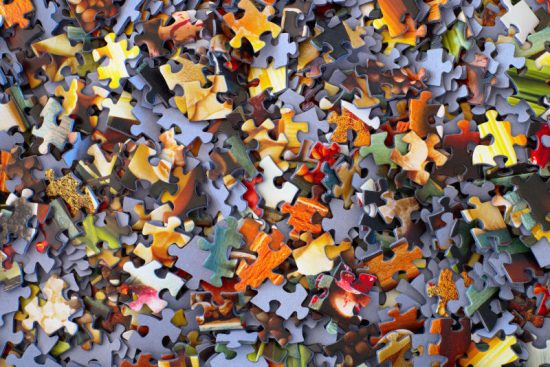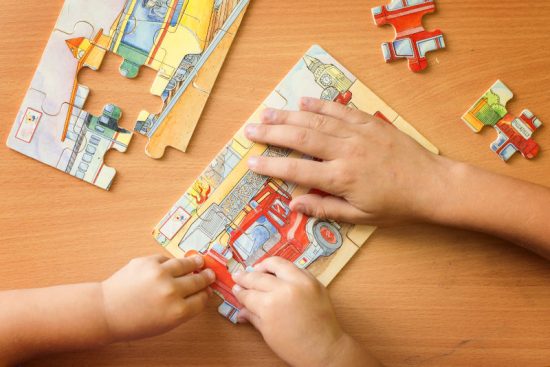This page may contain affiliate links. If you purchase something through one of the links, we may receive a commission at no extra charge to you. Still, we would include only products we actually trust and believe will be helpful for you.
Your toddler’s chubby hands grasp at puzzle pieces, trying to force them together. You cringe as your child jams the pieces together.
But, with practice, in a few short months, not only will the same jigsaw puzzle be a piece of cake, but your child will also find it easy to solve other similar puzzles. Why?
Your kid’s brain will have changed.
A favorite toy of educators and parents alike, puzzles are deceptively simple. All you have to do is put pieces together to make a whole.
But despite their apparent simplicity, puzzles are a fantastic learning tool that teaches youngsters many essential life skills. What are they?
Below, discover 11 benefits of this educational toy for child development along with some practical tips.
1. Concentration
Is your child’s attention span about a minute long, tops?
You’re not alone. This is actually common in young children.
Child development experts say you can expect your little one to concentrate for about 2-5 minutes times their age. That means a 3-year-old might be able to concentrate on a task for 6 to 15 minutes while a 4-year-old might last 8 to 20 minutes.
And you know what, puzzles are such perfect tools to build those concentration muscles in kids.
Paying attention includes possessing the ability to focus on one thing for a sustained period of time. Working on a puzzle until completion does give kids the chance to work on one task, uninterrupted.
But for children to get the full concentration benefit from puzzles, you should choose one that is age-appropriate. If it’s too difficult, kids get impatient and give up. But, puzzles that are too easy don’t provide enough challenge to boost your child’s focus and patience.
Do you need some guidelines?
For a one-year-old, knobbed puzzles with few pieces are usually most appropriate. But, for a 3-year-old, try a 16 to 20-piece jigsaw puzzle with large pieces. Older children can handle even more difficult puzzles.
Of course, these are just general guidelines rather than set-in-stone rules.
For instance, you could provide a 50-piece floor puzzle to a kid who’s only 3 years old. But that would probably require you to help the child at the beginning to avoid getting them frustrated.
By the way, we’ve actually written a comprehensive article on how to choose a child puzzle and types of children puzzles, if you want to check them out.
It’s inevitable sometimes that kids need some support to be able to solve a puzzle. If that sounds like your little one:
- You can start by assembling the puzzle with them or offering some verbal guidance.
- Then, as your kid builds their skills, try to gradually decrease your intervention.
- Eventually, you should be able to sit nearby and just watch as they concentrate without your assistance.

2. Spatial Awareness
When playing, your child tries to drive a toy car under a bridge. You can easily see that the bridge is too short. But, your kid discovers this when the car bumps into the bridge.
In this example, your child is building spatial awareness.
It basically involves being aware of yourself in space and how other objects relate to each other and you. Spatial awareness also involves understanding how relationships between objects change when one or more of them is moved.
While solving puzzles, spatial perception comes into play big time.
Children learn to identify which pieces will fit together by analyzing their shapes and colors. They must turn pieces around to find the correct fit. Slowly, they learn to do this in their heads rather than by trial and error.
Researchers from the University of Chicago actually confirmed the link between spatial awareness and puzzle play. It turns out that 2-4 year olds who played with puzzles improved their spatial perception skills much more than those who didn’t.
Here is how you can help the child develop their spatial awareness:
- Do puzzles with your kid. And try to use plenty of spatial language while playing such as “turn, beside, above, below, between, next to, outside, to the right, to the left, etc.”
- When working on a puzzle, choose a space you’re going to fill. Then, offer your child two different pieces, one that will fit, and one that won’t. Ask them to guess which of the two pieces will fit just by looking and to test their choice afterwards.
3. Shape Recognition
Toddlers need to learn to distinguish between shapes like circles, triangles, rectangles and squares. At first, they may think that squares and rectangles are the same. Slowly, they learn to identify the properties that make shapes unique.
Some simple puzzles (especially the ones with knobs) teach geometric forms or the outline shapes of vehicles, animals or people.
More complex jigsaw puzzles also require that your child recognize shapes when they fit the pieces together. For example, kids learn that edge pieces feature a straight line and don’t fit in the middle of a puzzle.
Why is this important?
Because it helps kids learn their letters and numbers. Before your child can ever identify the letter “A”, they have to be able to recognize shapes in general.
You can help your little one work on shape recognition by purchasing puzzles that feature geometric forms. When you do them together, say the names of each shape and ask your child to repeat them.
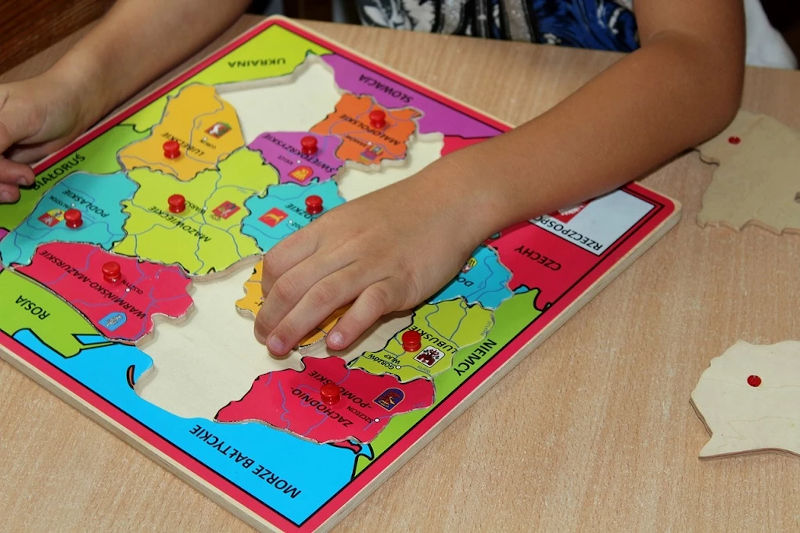
4. Topic-Specific Knowledge
Have you ever seen a map puzzle? Or perhaps a dinosaur puzzle?
Puzzles often cover many different topics, which can assist your child to learn about the world. From geography to habitats, parts of the body and more, this educational toy can help kids become familiar with just about anything.
Montessori programs are famous for using puzzles to teach children about botany and zoology. Beautiful wooden puzzles separate the parts of a flower, tree, fish, and other animals, making them a perfect learning tool.
You can further educate your kid by talking about the images on the puzzle. This will build your little one’s vocabulary and subject area knowledge, which can aid them tremendously in school.
5. Fine Motor Skills
A baby’s chubby hands struggle to grasp at a small toy. But, they drop it after banging it on the floor a few times. Babies are really quite clumsy.
Even most toddlers can’t do buttons, write, or pour juice without spilling.
That’s because very young kids are still building their fine motor skills.
This ability involves small movements that use the wrist, fingers, hands, feet, and toes.
It takes time for children to develop smooth fine movements. In particular, the muscles in young hands need lots of practice holding and moving small objects accurately. This is actually what happens when the kid plays with puzzles.
Pegged puzzles in particular force toddlers to use the pincer grip. This is a crucial skill that they’ll later utilize to hold a pencil (or a paintbrush) in preschool and kindergarten.
Jigsaw puzzles also require that young ones make very precise movements in order to get the pieces to fit together.
It can be tempting to step in and help your child with tasks that require fine motor abilities. But, it’s best to let them practice on their own, unless they seek assistance.
So, refrain from guiding your little one’s hand when putting puzzles together.
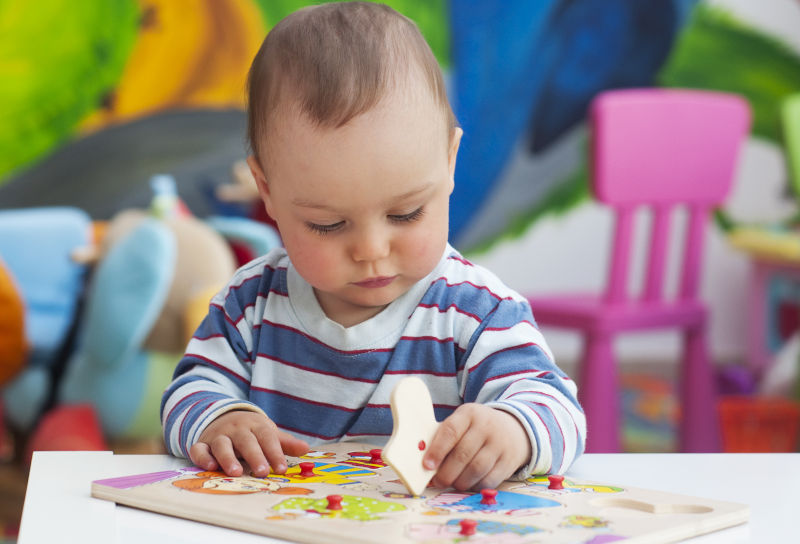
6. Hand-Eye Coordination
As your preschooler moves her hand to write, her eyes watch the pen move across the page, sending information to her brain about how to manipulate the pen. The pen wobbles and your little one grows frustrated that her efforts didn’t result in a perfect letter “b”. Slowly, she’s improving her hand-eye coordination which is essential for good handwriting.
Little kids must develop this skill by giving their eyes and hands plenty of practice working together. It begins from the moment babies wave their hands above their head and learn to put them into their mouth.
Puzzles are particularly effective at helping young children with their hand-eye coordination.
To solve a puzzle, youngsters must carefully move pieces into place. Before placing a piece, the toddler sees the spot where it will go with their eyes. Then, they must make their hands move the piece to that exact space.
So, make sure you give your child adequate independent practice by limiting your involvement.
Instead of guiding your kid’s hand, offer some helpful instructions such as “Lift the piece a little.” Or “Wiggle the piece a bit until it fits.”
7. Problem Solving Skills
Putting a jigsaw puzzle together presents a basic problem. The pieces are all mixed up, and must be organized and assembled. This creates a chance to learn problem solving skills.
Parents and educators can assist children to complete puzzles by teaching them strategies. Here are some easy ones you can try:
- After dumping a puzzle out, you might tell your little one to turn all of the pieces over so that the picture side of all pieces is facing up.
- Show your child how to identify edge pieces. Then, put the outline of the puzzle together first.
- Teach the kid to sort the pieces by color, or object. For example, if there’s a red flower in the puzzle, look for red pieces and put them together in a pile.
These sorting strategies teach kids to break down a large task into smaller ones. That’s a very important problem solving skill for school students.
Then, children must also make decisions when putting puzzle pieces together. What if a piece won’t fit?
You might suggest that they turn the piece around, or save it for later. Slowly, your little one will learn when to keep trying and when to set a piece aside.
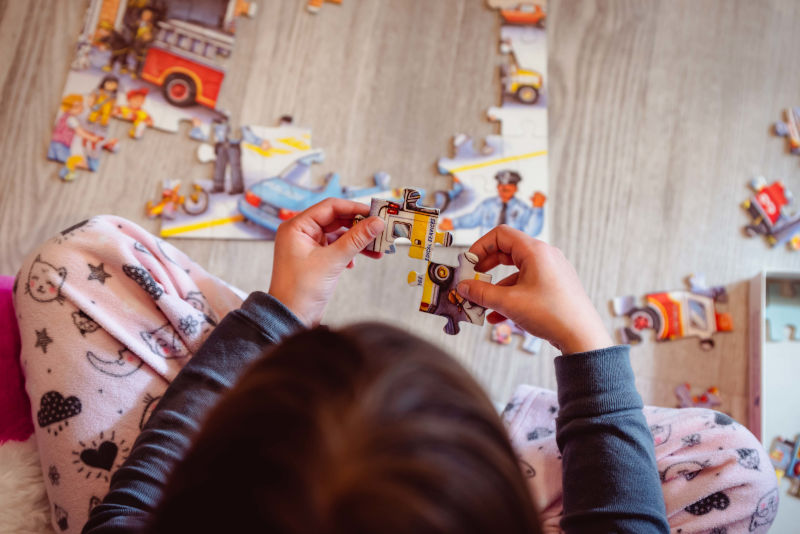
8. Language
Some children are chatter boxes. Others are quieter. But, all kids can benefit from hearing new words.
Experts in early childhood language development say that children need to be spoken to and lots, especially during their early years of life.
When you speak to your kid, you expose them to new vocabulary words. The number of words your little one hears may be directly related to the size of their vocabulary later on.
After solving a jigsaw puzzle, children are typically interested to learn about the assembled image. So, they talk with their parents and ask questions about things they see in the puzzle like the different animals and plants. This helps them learn new words and develop their speech.
As a parent, you can also take the initiative here by playing some language games such as:
- After the puzzle is complete, ask your little one to point to items of different colors or to identify different objects, then to talk about them.
- With the puzzle fully assembled, ask your child to specify the quantity or type of a certain object in the image. For instance, you might inquire “how many trees do you see?” or “what type of plants are there?”
- Ask your kid to describe what they’re doing in a running commentary. For example, they might say “I’m picking up a yellow piece and I think it fits with the sun.”
You’ll eventually hear your little one saying the same words you used during the puzzle play, which will improve their language.
Remember, a child might have to hear a new word a few times before using it themselves. So, be patient and keep talking.
9. Memory
Puzzles keep your kid’s mind active and working. This is especially beneficial for the short term memory.
How does it work?
A girl might be doing a puzzle, when a flash of a color on a piece reminds her of a color she already saw. She quickly locates the other piece and put the two together.
Many experiences like this one can actually increase the speed of connections in the brain, making it more efficient.
Because kids often assemble the same puzzle over and over again, they might also recall which pieces go together. This is another way they boost their memories.
To further build your child’s memory, here are two activities you can implement:
- Let the kid practice doing the same puzzle several times. Each time, set a stopwatch to see how quickly they can complete the puzzle. Gradually, their speed should improve.
- When the puzzle is complete, tell your child to look at the image for one minute, then to close their eyes or turn around. Next, ask them questions about the puzzle to see how much they remember. For example, you might ask, “What color is the cat?”

10. Self Esteem
“I did it!” your child shouts, after placing the last piece in a puzzle. “Come and see,” they say excitedly.
There’s something very satisfying about solving a puzzle. All of the pieces are lined up perfectly showing a beautiful picture. What was disorder and mess is now organized and neat.
Finishing a project brings a sense of accomplishment. There’s finality in placing that last piece.
When completing a puzzle, your little one adds to their list of achievements which builds their self-esteem.
For kids, puzzles also offer a rare chance to perform a task on their own.
Young ones need help with almost everything from going to the bathroom to reading books and getting a snack. But, to put together an age-appropriate puzzle, they typically don’t need any support from adults.
Puzzles are self-correcting. Either the pieces fit or they don’t.
So, children can enjoy working independently on puzzles. This independence improves the sense of self-worth.
If your child hasn’t played with puzzles before, they might find it challenging to do them on their own at first.
Use lots of positive reinforcement to help your little one develop their confidence. For example, after putting a piece in place, you might say “You did it!”
You can also praise your kid’s efforts, helping them see the connection between their persistent work and achievements. For example, “You’re working so hard and now you put another two pieces together!”

11. Social Skills
Two children are doing a puzzle together. Suddenly, they both reach for the same piece. “Hey, that’s mine!” one of the kids says, angrily, snatching up the piece. The other won’t let go of it either.
This may sound like a negative interaction, but it’s also a learning opportunity.
Assembling a jigsaw puzzle with someone else requires cooperation and communication.
While putting together puzzles, little ones have the chance to practice their social skills. From resolving a disagreement to asking for help finding a piece, kids learn important lessons as they work with each other.
When you do a puzzle with your child, you can model social skills. For example, you can use courtesy words and polite language to ask for a piece or suggest a strategy. Before you know it, your kid will try out these practices when working with others.
Engaging in puzzles helps children enhance their social skills by fostering cooperation and communication. Through negotiation skills exercises, such as resolving disagreements over puzzle pieces and asking for assistance, kids learn valuable lessons in teamwork and courtesy. This interactive play not only develops their problem-solving abilities but also prepares them for more complex social interactions in the future. – Founder of Shapiro Negotiations Institute
The Bottom Line on Puzzle Benefits
From fine motor, to problem solving, to self-esteem, the advantages of puzzles for children’s development are numerous. This educational toy is obviously important for kids to learn cognitive, physical and emotional skills, which will support them later on in life as they grow up.
You can maximize those benefits by following the tips suggested throughout the article.
It’s worth mentioning this fun toy presents a great opportunity for parents to interact in a positive way with their kids. With a jigsaw puzzle on the floor, you’ll smile, laugh and relish completing a task together. That’s in addition to the fact you won’t need to pay a lot for puzzles thanks to their affordable prices.
Want a final piece of advice to let your kid learn the most from puzzles and continually develop the skills listed in this article?
Keep increasing the difficulty of the puzzles you bring home, as appropriate (i.e. higher number of pieces, more complex image, or smaller pieces). With this, your little one will well be on their way to become a highly intelligent adult in the future.
In case you face any difficulty in choosing an appropriate puzzle for your child, you can use the suitable puzzle size calculator we have developed. It will help you to quickly know the suitable number of puzzle pieces for any kid age (and vice versa).
Following is a beautiful graphic that summarizes all the puzzle benefits mentioned in this article.


